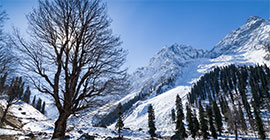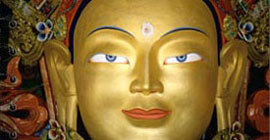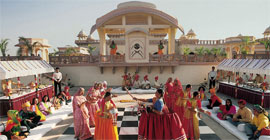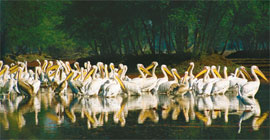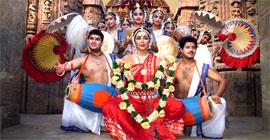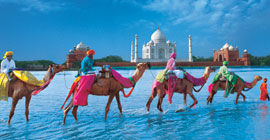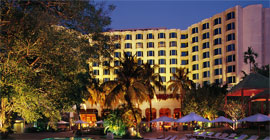VADODARA
Home | Vadodara
Vadodara , formerly Baroda, is the capital city of the Gaekwar State, is situated on the banks of the Vishwamitri, a river whose name derived from the great saint Rishi Vishwamitra. It is located southeast of Ahmedabad. It is the administrative headquarters of Vadodara District.
Vadodara is home to almost 1.6 million people. (as of 2005), the beautiful Lakshmi Vilas Palace and the Maharaja Sayajirao University of Baroda (M.S.U.) which is famous for various departments, including the Fine Arts, Performing Arts, Technology, Management, Psychology, Social Work and Medicine streams. It has a high literacy rate by Indian standards of 78% (2001). Major industries include petrochemicals, engineering, pharmaceuticals,plastics and Forex.
History
Vdara hadoas a rich historical background. The ardent historian can trace Vadodara's history over 2000 years and more. The first noted history of the city was of the early trader settlers who settled in the region in 812 A.D. The province was mainly Hindu-dominated with Hindu kings ruling till the year 1297. The Gupta Empire was the first power in the region in the early years of the Christian Era. After fierce battles, the region was taken over by the Chalukya Dynasty. Finally, the kingdom was annexed by the Solanki Rajputs. By this time the Muslim rule had spread across India, and the reins of power were then snatched by the Delhi Sultans. The city was ruled for a long time by these Sultans, until they were easily overthrown by the Mughal emperors. The Mughals' biggest problem were the mighty Marathas who slowly but eventually took over the region. It became the capital of the Maratha Gaekwads. Sayaji Rao III (1875-1939), a most able ruler, made many public and bureaucratic improvements in the region. Although the British had a major influence on the region, Vadodara remained a princely state until Independence. Like all other princely states, Vadodara also joined the Dominion of India in 1947.
The city was once called Chandanavati after its ruler Raja Chandan of the Dor tribe of Rajputs, who wrested it from the Jains. The capital had also another name Virakshetra or Viravati (Land of Warriors). Later on it was known as Vadpatraka or Vadodará, which according to tradition is a corrupt form of the Sanskrit word Vatodar meaning In the heart of the Banyan tree. It is now almost impossible to ascertain when the various changes in the name were made; but early English travellers and merchants mention the town as Brodera, and it is from this that the name Baroda is derived. In 1974, the official name of the city was changed to Vadodara.
In 1907, a small village and township in Michigan, United States was named after Baroda.
It is also rumoured that the name Baroda originated from two words Vat which means the Banyan tree and Aodh, which means a tent/canopy. According to a popular legend, the region in and around present day Baroda was full of Banyan trees that formed a dense cover that looked like a huge tent canopy from a distance. Thus the name Baroda stuck.
Old Ankotakka
The early man lived on the banks of the river Mahi. This river must have formed the flood plain during that age. The movements of these “food gathering” parasites on nature, living on the banks of the river, grumbling the roots and killing animals with crude stone tools made out of the cobbles and pebbles available on the river bank, were necessarily controlled by the availability of convenient raw materials for their tools. There are evidences of the existence of early man in the Mahi river valley at a number of sites within 10 to 20 km to the north-east ot Vadodara. No evidences however of the existence of this man are found in and around present Vadodara. This may be because of the absence of gravels and cobbles on the banks of the Vishwamitri rivulet.
The next phase of the pre-historic Vadodara witnessed the first human settlement on the right bank of the river Vishwamitri on a group of dunes resting on the alluvium of the river. It also means that men knew about where to set up settlements, as they had selected an elevated land. The Vishwamitri must have been prone to seasonal floods even then. These people still belonged to the stone age, crafting their tools with finely grained stones. From their material culture and physical environment, they seem to have belonged to the same culture as those whose implements were found in the Mahi river valley. This human settlement has been dated to 1000 B.C.
Around the beginning of the Christian Era, a small township developed at the same spot as the above mentioned settlement on the right bank of the river. It came to be know as Ankotakka (present day Akota), the mound on which this settlement was established came to be known as Dhantekri. The entire settlement was developed by clearing grazing land and forests of Ankhol and covered an area of ½ to ¾ sq. km. This is indicative of the presence of thick forests during those times. Due to its location on the ancient trade route between Gujarat and Malwa, this small township flourished in to a commercial entre. There was a supposed commercial relation between this township and Rome.
The township of Ankotakka developed during the rule of the Guptas and the Vallabhis. It was subjected to periodical heavy floods. But a severe flood which inundated the renovated public hall, forced the inhabitants to abandon this township and move away from the banks of the Vishwamitri.
The event occurred in 600 A.D. The inhabitants moved to the east of Ankotakka to another elevated portion located on the present Kothi area. This formed the nucleus of a new township.
Transport
The city is on the major rail and road arteries joining Mumbai with Delhi and Mumbai with Ahmedabad. Due to this Vadodara is known as a Gateway to the Golden Quadrilateral.
Air
Vadodara Airport (IATA: BDQ) is well connected with the Metropolises of Mumbai, Delhi, Bangalore, Kolkata and Chennai with multiple daily flights to these locations. Some flights operated (by Air India) to and from Delhi fly via Ahmedabad.
Rail
Vadodara was part of historic BBCI Railway. Railway had arrived in Vadodara in the early 1860s. On November 5, 1951 the BBCI Railway was merged with the Saurashtra, Rajputana and Jaipur railways to give rise to the Western Railway. Now, the Vadodara Railway Station belongs to the Western Railway division of Indian Railways and is a major station on the Mumbai-Delhi and Mumbai-Ahmedabad routes. All trains, including Superfast and Express, stop here. Vadodara has 3 railway stations namely Vadodara Junction (BRC), Makarpura & Vishwamitri.
Road
National Highway No. 8, connecting Delhi & Ahmedabad to Mumbai, passes through the city. Vadodara is also connected with Ahmedabad through Indian National Expressway 1, a stretch of 97 km Super Highway with only 2 exits.
Culture
Aarkee Garba during Navratri FestivalVadodara is also known as ‘Sanskari Nagari’, i.e. Cultured City. Vadodara is one of India’s most cosmopolitan cities. Thanks to the vision and broadmindedness of the Gaekwads, the subsequent industrialisation, the proliferation of academic activities and a strategically important geographical location, Baroda has welcomed a wide variety of people from all over India and also from all over the world. In all of this, the sprawling and cosmopolitan MS University campus and the large number of local, national and foreign industries act as a catalysing and unifying force.
The great museums on the palace grounds such as the Maharaja Fateh Singh Museum and art gallery are unique and carry artifacts from around the nation and the world. There are Gujarati film studios in the city as well as a large number of large old-style movie theatres in addition to the newer multiplexes that have sprung up in the past few years.
Diwali, Uttarayan, Holi, and Ganesh Chaturthi are celebrated with great fervour. Classical music and dance have their patrons, and so does the modern stage and pop culture. The culture and the traditions are both alive and being forever experimented with.
Navaratri or Garba is the city's largest festival, with song, dance and lights during every October. Many of the residents spend their evenings at their local Garba grounds where local musicians play traditional music while people dance the Raas and Garba dances which often goes on past midnight. This is also a time when the youth are more visible outdoors and until later than other times of the year. The people of Vadodara have preserved the original and the traditional part of the Navaratri. Garba in Vadodara attracts a fairly large number of international tourists.
Places of Interest
Laxmi Vilas Palace
Nazarbaug Palace
Makarpura Palace
Pratap Vilas Palace
Buildings & Monuments: Maharaja Sayajirao University of Baroda, Kirti Mandir, Kirti Stambh, Nyay Mandir, Mandvi & Walled City, Khanderao Market, Aurobindo Ashram, EME Temple (Dakshinamurty Temple), Hazira Maqbara, Tambekarwada, Kala Ghoda, Juni Kothi, Central Jail, Kala Bhavan, Motibaug Palace, Sursagar Lake
Museums & Gardens: Maharaja Fateh Singh Museum, Baroda Museum & Picture Gallery, Sayaji Baug, Jubilee Baug, Lal Baug, Sardar Baug
Other Interesting Places: Malls and Multiplexes (Vadodara Central, Spencers, PVR Deep, Chandan, Inox, Westside, More, View of Sursagar), Gandhi Nagar Gruh (Town Hall), Vadodara Central Library, ABS Tower Art Gallery
Excursions: Ajwa & Nimeta, Dabhoi, Pavagadh, Champaner, Sindhrot Nature Park, Shoolpaneshwar Wildlife Sanctuary, Kayavarohan, Chandod, Galteshwar, Dakor, Nareshwar, Sankheda







